Vacuum tube game in 21st century
Playing vacuum tube is not so difficult as expected. Let's play great heritage of human being by modern technology!
Playing vacuum tube is not so difficult as expected. Let's play great heritage of human being by modern technology!
To make the experience fit your profile, pick a username and tell us what interests you.
We found and based on your interests.
Radio_case_part2.stlRetro radio enclosure part 2/3Standard Tesselated Geometry - 593.54 kB - 06/01/2019 at 12:49 |
|
|
Radio_case_part1.stlRetro radio enclosure part 1/3Standard Tesselated Geometry - 152.82 kB - 06/01/2019 at 12:49 |
|
|
Radio_case_part3.stlRetro radio enclosure 3/3Standard Tesselated Geometry - 49.89 kB - 06/01/2019 at 12:49 |
|
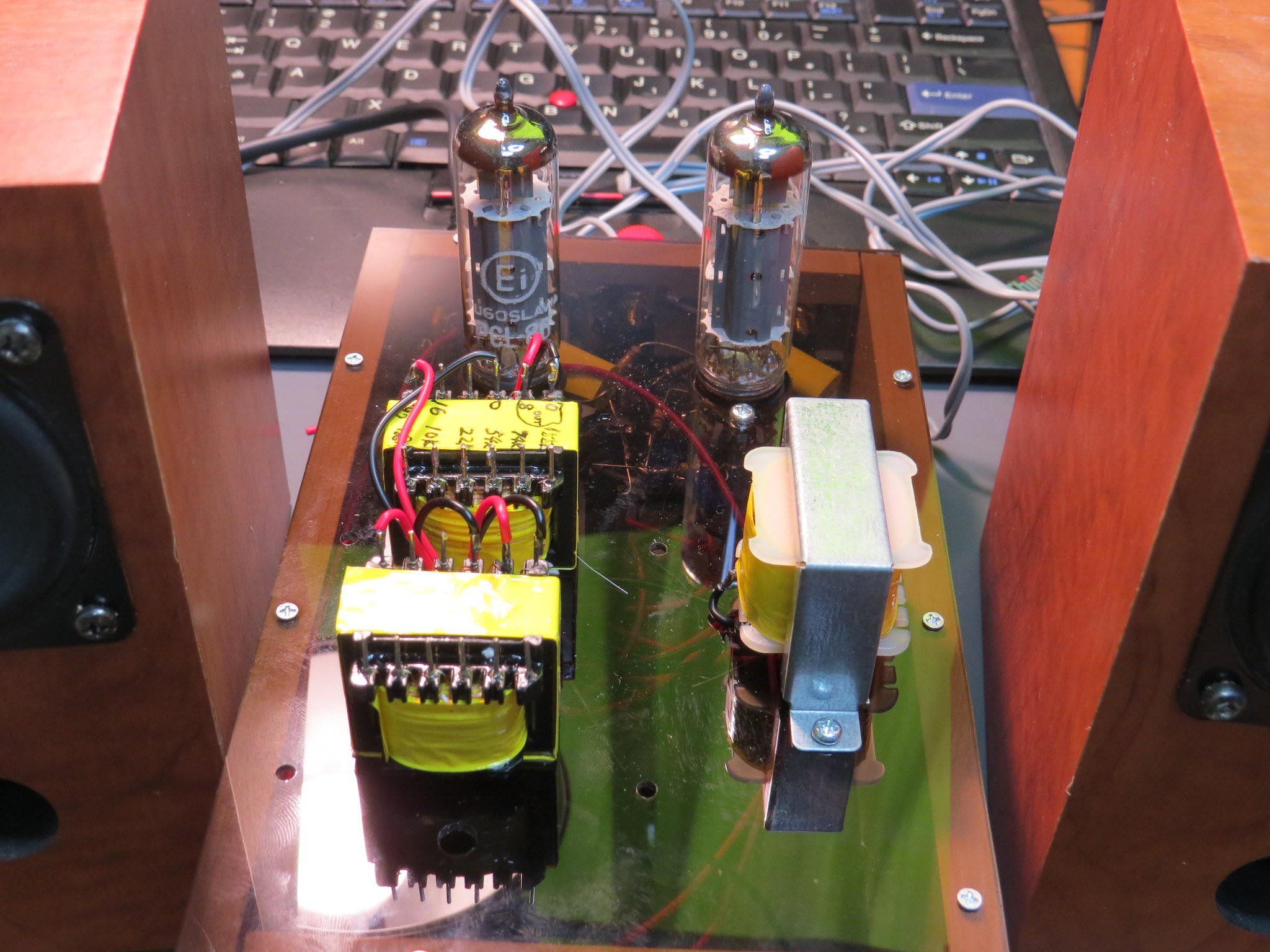
At the beginning of this hackaday project, I did not know well about vacuum tube amplifier. But now I've made and designed several things, including radio (reflex, super-regenerative, superhetrodyne..), amplifier (subminiature, type-19, type-38, 6SN7, 14GW8) and got to know what's vacuum tube, and how wonderful sound can be generated by it. So now I would conclude this project with this 14GW8 vacuum tube stereo amplifier. The output trans is modified cheap autotransformer and the plate voltage is directly generated by rectified AC 100V. The heater voltage is simply obtained by DC 15V switching AC/DC adaptor. Through this project, I got to know vacuum tube circuit is not black magic but it is surely working if properly designed. I had a knowledge of transistor circuit (and to tell the truth, I've had a course for more than 20 years at several university), and I got to know the basic knowledge is exactly the same between transistor and vacuum tube. (except for heater voltage requirement..)
And the above movie shows the operation of single tube (for each channel) stereo amplifier. The 14GW8 surely has a very high gain, and it is quite useful for simple audio power amplifier!
Thank you for interest!
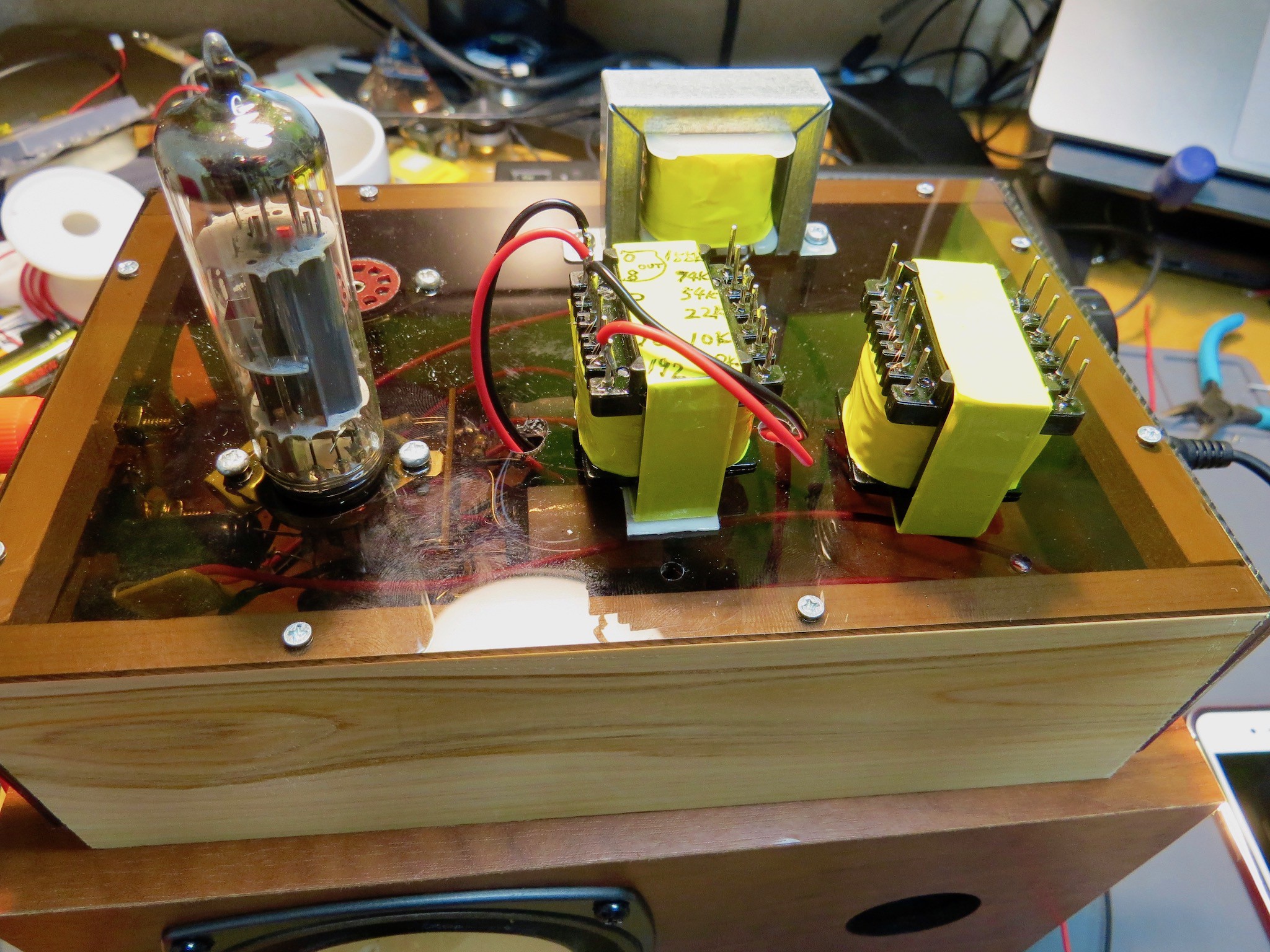
If you are rich enough to buy audio output trans as you wish, this log may not be useful at all. Just before I've completed 6SN7 stereo amplifier, which needs two output trans, and I have just two trans, so my 14GW8 amplifier lost its output trans. This time I tried to make "cheap output trans" by audio autotrans (matching trans) and succeeded to revive my 14GW8 amp with this.
Autotransformer is very quick way to realize impedance conversion (or AC voltage conversion), but the primary and secondary side are not isolated. As you know, the plate voltage of output tube is applied through transformer, and if the secondary is not isolated, your speaker will get fire (or burn) by the applied B voltage. One quick way to isolate DC is inserting capacitor of one side of speaker out, but I want to avoid any additional insertion of R, L, C, because they will limit (put color) the sound taste. (I am not audio maniac, though..)
I quickly recheck the trans in my hand (available at aliexress or else), if we cut the connection between pin 2 and 3 in the above image, at least we can use #1 and #2 for speaker out (8-ohm), now the #3 becomes new 0-ohm terminal of the primary side, and we can choose primary impedance as we wish! Of course, primary-secondary are isolated and the plate voltage can be applied through "new 0-ohm" terminal. The price of this trans is just around $5 and we can get very low price output transformer! (If you are not pious audio maniacs..) The movie below shows the actual operation. Indeed its sound quality is not so bad (not extreme, I think. I have no will to fight with $$$ transformer.) and this quick hack will be very useful for making low price vacuum tube amplifier.
Yes it is working (and also now the end of my vacuum tube game?)
Ancient commercial product was quite simple and also all of schematic were released for fixing/repair purpose. (Today's product is ultra complex and not so many people will be happy even iPhone releases full schematic).
By reading the schematic, I've put two hack for my retro radio (ONKYO OS-195).
By measuring local oscillator frequency, we can guess the receiving frequency (one concern is, whether it is exact 455 kHz IF or not..). My frequency counter has a function of IF frequency subtraction, and putting one terminal from local oscillator part, YES, now the reception frequency is digitally readable!
It is just fun to see the reception signal strength monitor. Mostly this is done by Magic Eye but the enclosure does not have enough room for it. (and also I wonder how to get heater voltage, because it is series connected trans-less heater driving..)
So this time I added one 3.5mm jack terminal on the top of the radio, which is connected to AGC voltage portion. This meter is just showing the AGC voltage, leading to S-meter!
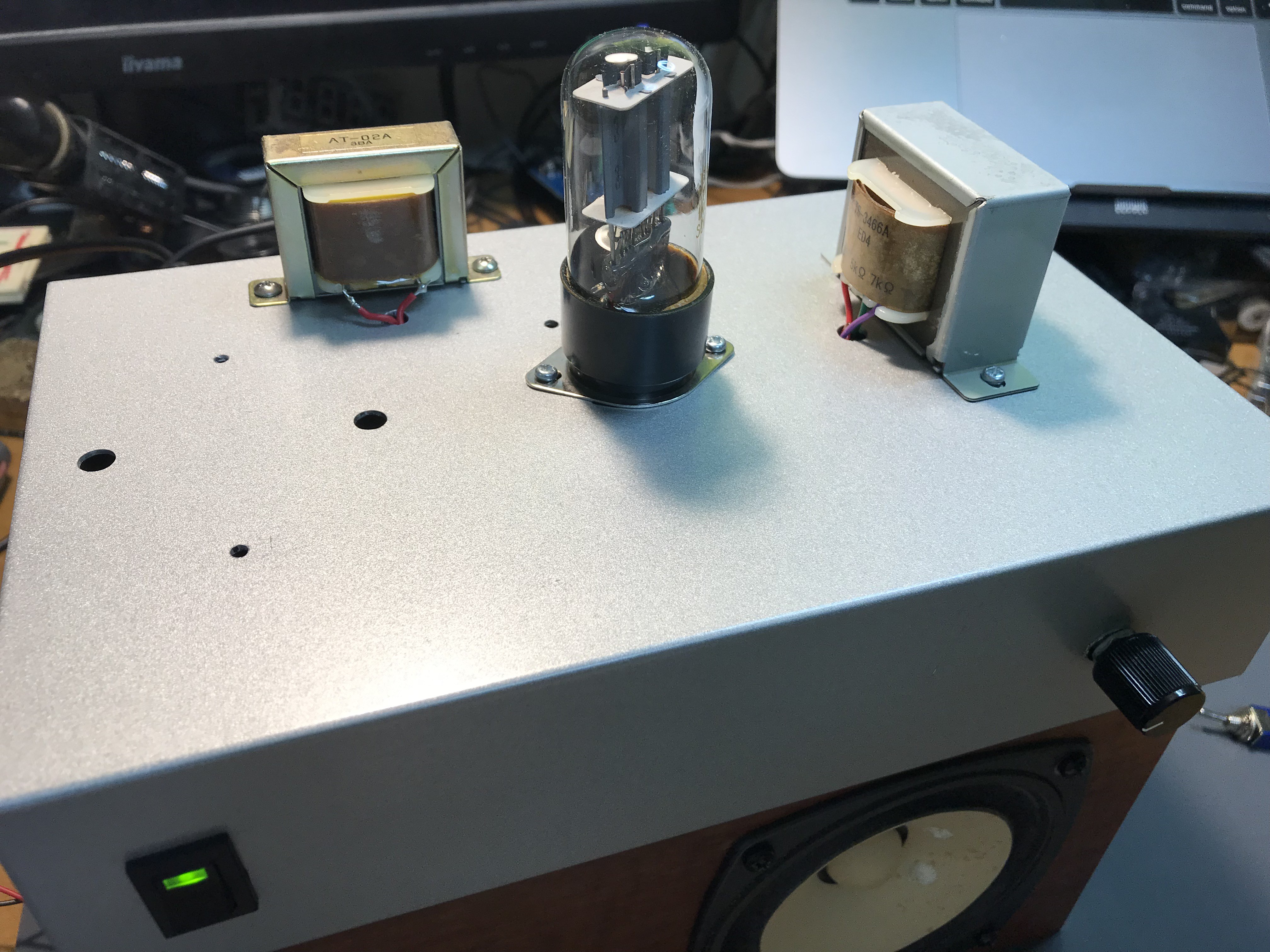
I thought my previous made amplifier by type-19 push-pull is the best, but it was not. This time I made a single tube audio amplifier by 6SN7.
6SN7 is very popular tube and mostly used for pre-amplifier but its max plate dissipation is 5W, so indeed it can support a few-W mini pre/power amplifier by using two triode (one is pre and the other is power).
The configuration is quite similar to my previous made. The heater voltage is generated by switching 6V AC/DC adaptor, and the plate voltage (around 140V DC) is generated by direct rectifying AC 100V. YES, no power transformer.
On the top, just output transformer and choke coil, and tube are settled. I have not tried without choke coil but by the sake of this choke, it does NOT produce audible hum noise. Actual operation can be found in the following movie... Have fun!
The reason why I am using this tube is, simply affordable. I cannot afford to get 300B but this tube is around $5 and good to try. The type 38 is very beginning of pentode in the history, but already heater voltage is 6.3, as same as more modern tube.
The configuration is a type of "audio maniacs will get angry". Heater voltage is generated by tiny AC/DC, and plate voltage is generated by AC 100V direct-rectified. So none transformer (except for the one in AC/DC) for power supply. It's easy!
On the top side, one output transformer and one choke coil for power supply. YES, that' all!
Actual operation can be seen in the following movie...
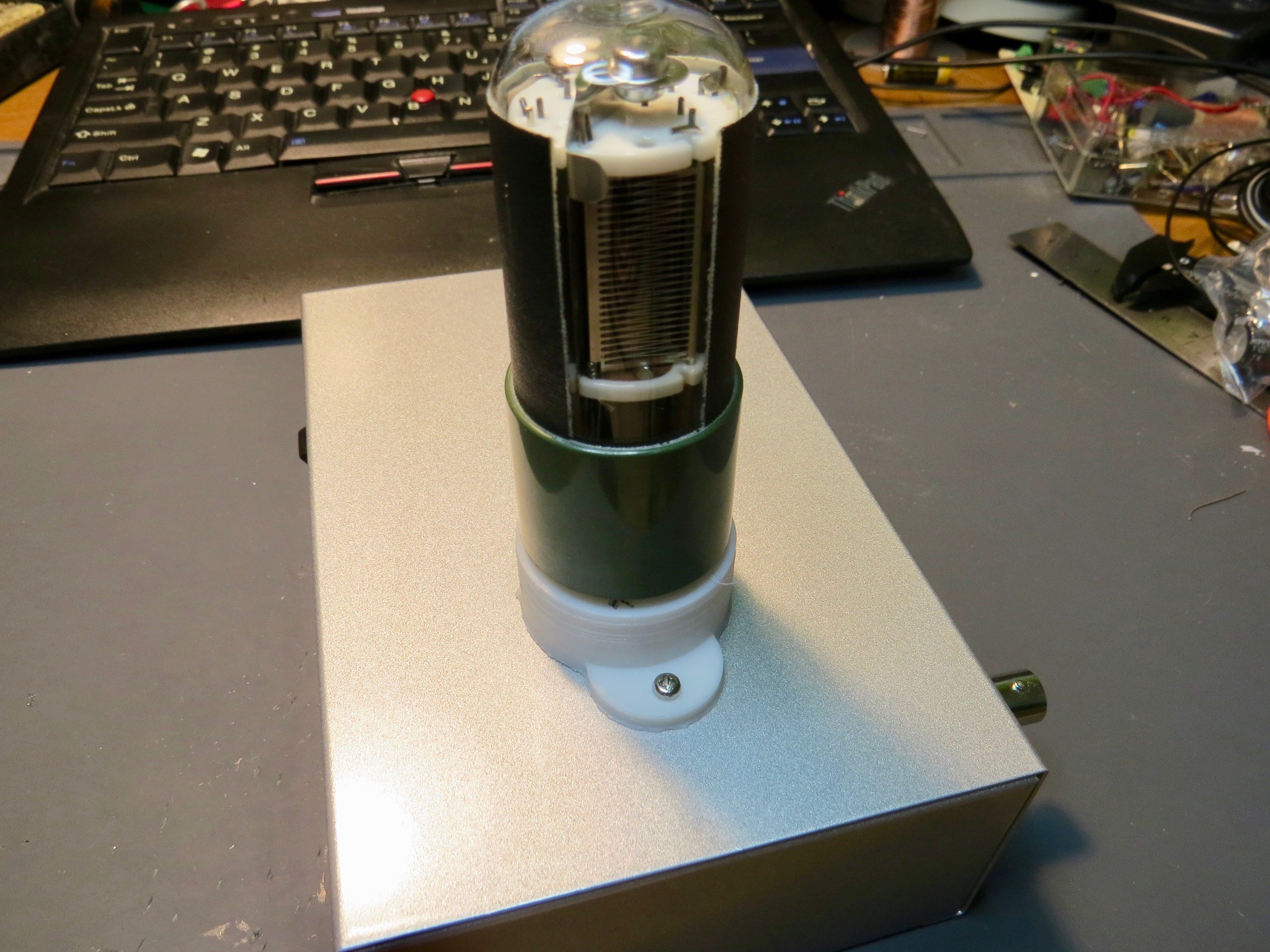
Eventually the tube is getting the present age. The tube is "photomultiplier", which is famous for the high-sensitive photon detector in Super Kamiokande (detect micro-weak light from Cherenkov radiation in a big water pool.) The tube requires high voltage, ideally 1000V for higher gain, but I know how it is dangerous. So this time I made 4x voltage rectifier for AC100, which can generates around 560V DC.
The tube is IP28, which has 9-stage photo multiplier, so 553V/9=61V is applied for each stage. Voltage divider is just series ohmic resistor as shown in the picture below.
The circuit is quite primitive but I confirmed its operation as very initial experiment as shown in the movie below. The next step will be radiation detection (I hope it will work as Geiger counter..) together with proper scintillator...
Recently I tackled with bigger tubes but now I have a quick return to sub-miniature tube.
It is quite simple amplifier by 5672 with output transformer (for transistor). It still requires 30V so I power-on with my previous making (3.7V to heater, B voltage generator board). Actual operation can be found in the following movie. Have fun!
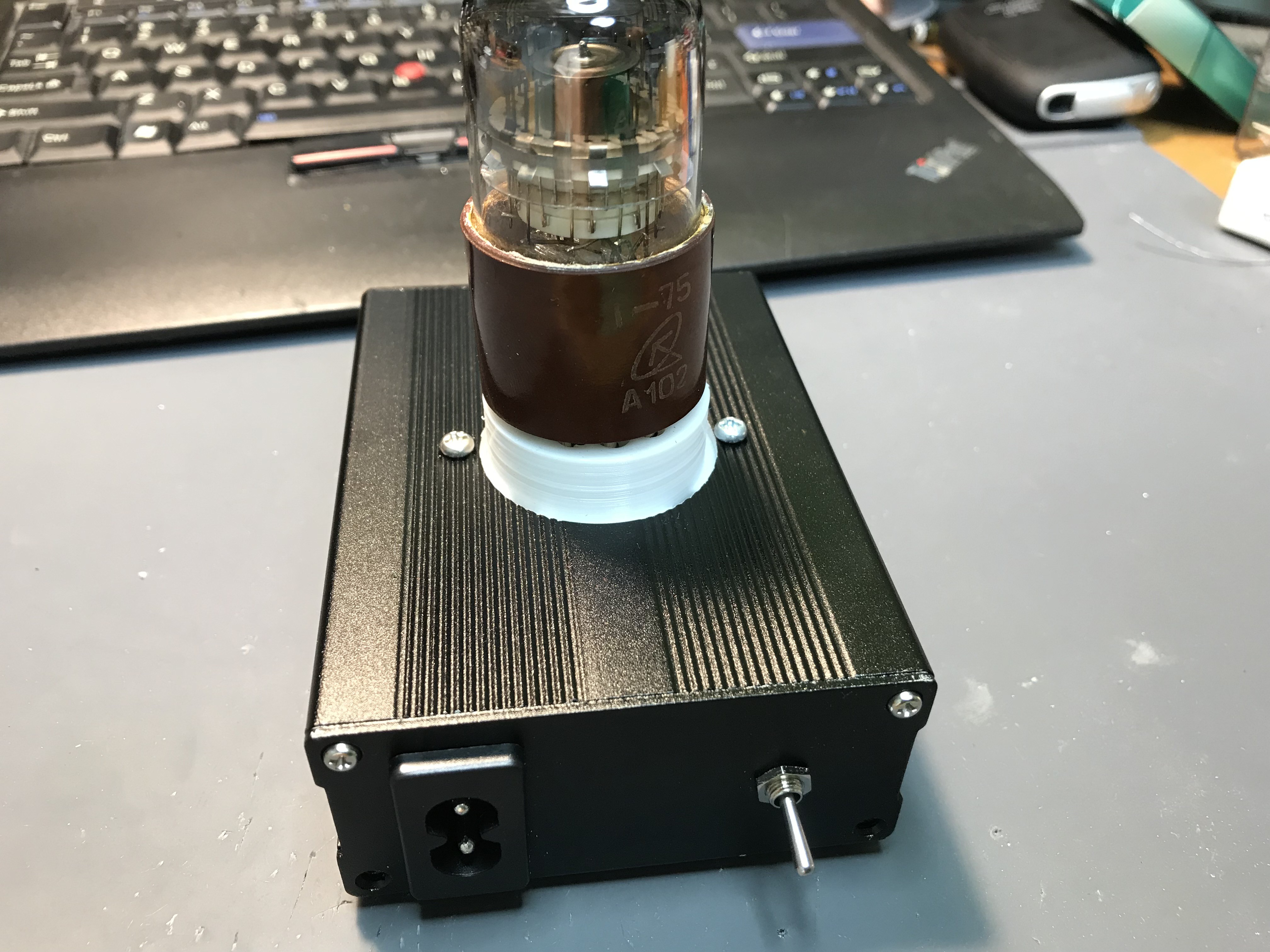
Indeed I've already got this unique tube before but till now I did not touch this tube. The neck was its special pinout. Indeed I don't have 13-pin vacuum tube socket, so this time I made it by 3D printing.
The circuit inside enclosure is quite simple, purely consisting of C, R, and diode. The plate voltage is generated by triple voltage rectifying and from AC 100V. (leading around 400V DC). For its light rotating, the tube requires two phase clock, same as rotary encoder. The current circuit generating 50 Hz two phase clock by just R-C phase shifter. This dekatron supports bi-directional rotation, so I added SPDT switch for phase capacitor for forward and reverse (CW, and CCW) rotation.
But maybe DEKATRON is the only one DIGITAL vacuum tube in the history. It is not just display like Nixie and VFD, but works as digital counter and memory and display.
Actual opration can be found in the following movie....
As you can watch the spinning color in the video, the color of A102 is not orange but blue-violet, meaning filling gas is not neon but argon or something else neon.
 This time I will try "Geiger-Müller" tube. It is a special tube for the detection of ionizing radiation, and requires high voltage around 400V. For this voltage requirement, I just use a parts kit of voltage booster and checked its operation. It is not so showy but I confirmed my place is safe ;-)
This time I will try "Geiger-Müller" tube. It is a special tube for the detection of ionizing radiation, and requires high voltage around 400V. For this voltage requirement, I just use a parts kit of voltage booster and checked its operation. It is not so showy but I confirmed my place is safe ;-)
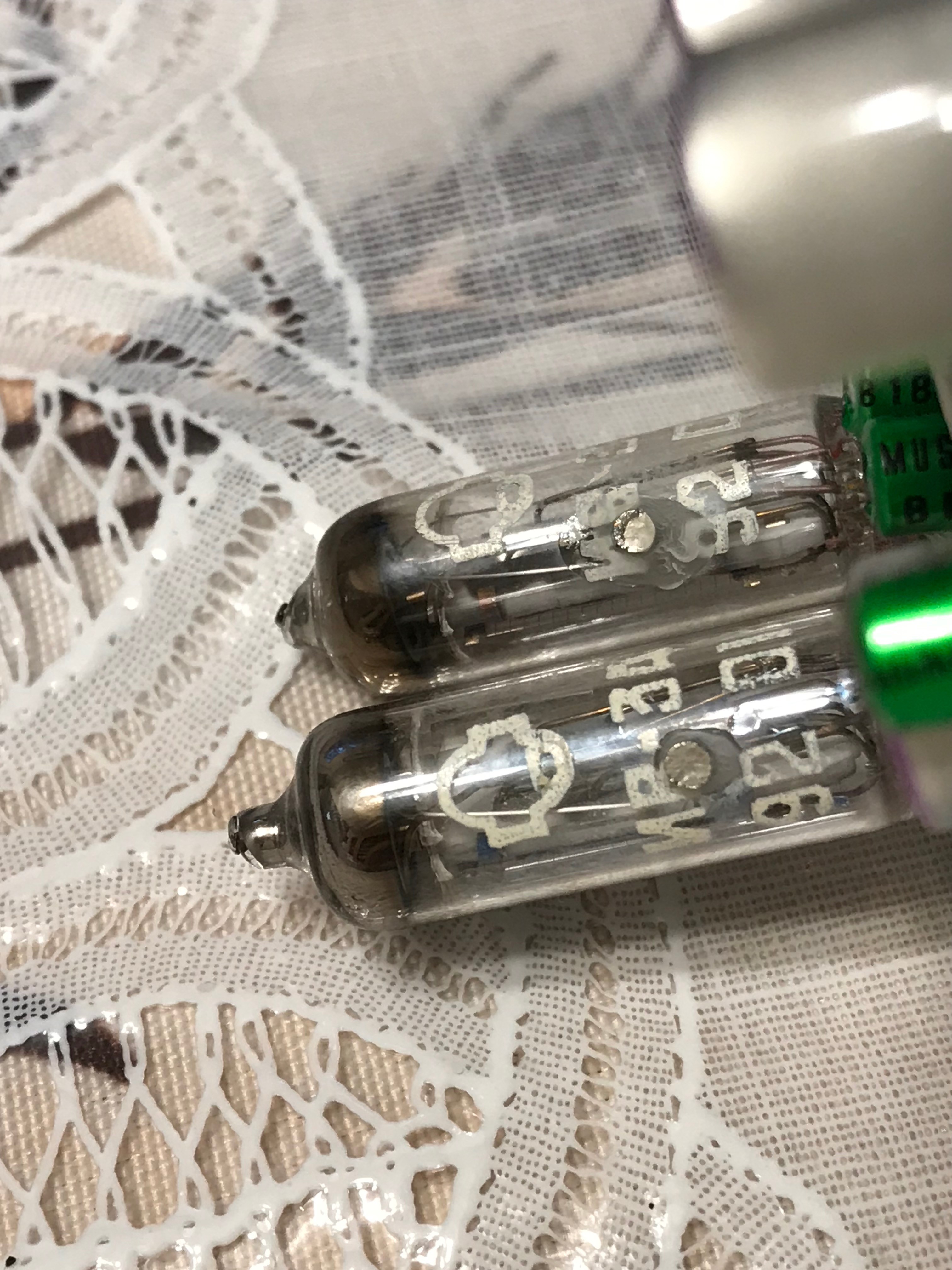
I know 7-seg VFD is NOT for audio amplifier but digit display, and I am rather "crazy", but eventually I overcome "crazy howling" issue. Without any trick, triode operation 7-seg VFD will cry and howl up to maximum its output. Unless your house is like " Little house on the Prairie", your neighbour will get angry for continuous noisy howling.
What's the trick? It is indeed conventional way to stabilize howling of direct-heated tube, putting magnet on the tube.
The picture above shows the actual way to reduce howling. It is quite "size and position sensitive" and bigger magnet will kill its amplification, and smaller one will not have any effect for it. Anyway I found the way!
Create an account to leave a comment. Already have an account? Log In.
Hahaha, nice. I played with the dangerous variety as a kid. Got an electric shock once but that wasn't due to the vacuum tube but some exposed mains wiring. A kid like me would be outlawed these days.
Hope you do a project using magic eye tubes sometime. Those were classic.
Become a member to follow this project and never miss any updates
Thank you for comment. Yeah, magic eye is quite impressive... I want to try..!